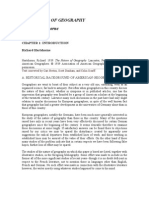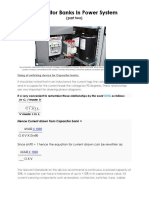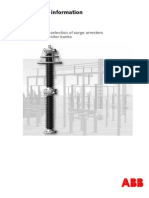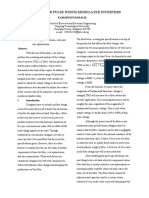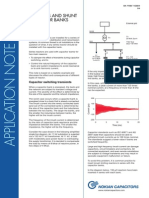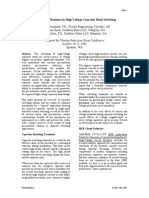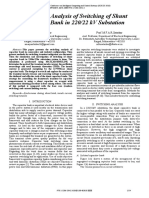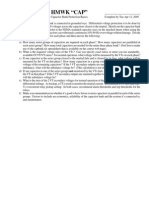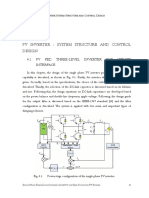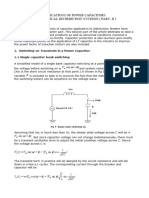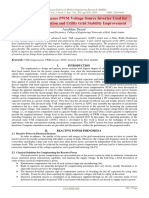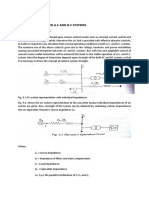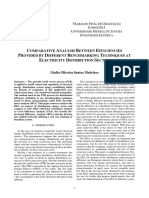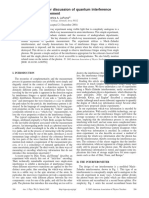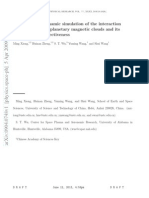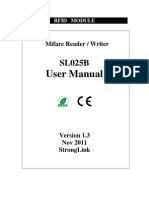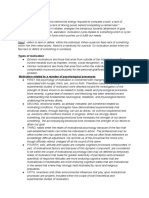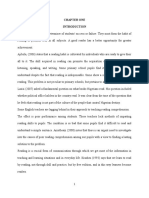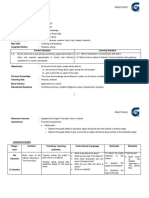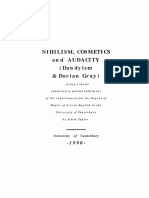Relaying 230 KV, 100 Mvar C-Type Filter Capacitor Banks: Abstract
Relaying 230 KV, 100 Mvar C-Type Filter Capacitor Banks: Abstract
Uploaded by
Antônio Ferreira RosaCopyright:
Available Formats
Relaying 230 KV, 100 Mvar C-Type Filter Capacitor Banks: Abstract
Relaying 230 KV, 100 Mvar C-Type Filter Capacitor Banks: Abstract
Uploaded by
Antônio Ferreira RosaOriginal Title
Copyright
Available Formats
Share this document
Did you find this document useful?
Is this content inappropriate?
Copyright:
Available Formats
Relaying 230 KV, 100 Mvar C-Type Filter Capacitor Banks: Abstract
Relaying 230 KV, 100 Mvar C-Type Filter Capacitor Banks: Abstract
Uploaded by
Antônio Ferreira RosaCopyright:
Available Formats
Page 1
Relaying 230 kV, 100 Mvar C-Type Filter Capacitor Banks
Randy Horton, Ted Warren Timothy Day, Jack McCall, Arvind Chaudhary
Alabama Power Company Cooper Power Systems
Abstract:
Shunt capacitor banks are considered an economical
source of reactive power and are installed in many
locations throughout the power system. The addition of
a capacitor bank creates a new, and lower resonant
frequency as the capacitance interacts with the inherent
system inductance. Recent years have seen greater
numbers of large industrial customers, with their non-
linear loads, connected to high-voltage portions of the
power system. If the harmonic current injected by these
nonlinear loads has appreciable components at the
resonant frequency of the power system, a severe over-
voltage situation can occur. As a result, the ability to
filter harmonic current with adequate damping over a
selected frequency range has become a necessity in
some shunt capacitor bank designs. The C-type
harmonic filter can be designed to meet these
requirements. This paper describes the design,
application, and novel protection of a C-type harmonic
filter bank.
Introduction:
Southern Company Services Transmission Planning
Department determined that 200 Mvars of capacitors
needed to be installed at a 230 kV substation on the
Southern System to provide voltage support. The 200
Mvar was split into two equal 100 Mvar banks. Both
banks were originally designed to be split-wye
grounded banks.
Harmonics were monitored at the station bus for one
week. With the collected data, it was determined that
there was an appreciable magnitude of current at the 5
th
,
7
th
and 11
th
harmonics. Preliminary calculations
indicated that the application of 100 Mvars and/or 200
Mvars of capacitors at this particular location would
create a harmonic resonance near the 7
th
harmonic.
Both present and future short-circuit strengths were
considered. Calculated voltage THD levels at this
particular location without filtered capacitor banks
ranged from 7.1 23.2%, depending on system strength
and how many area capacitor banks were on line.
These levels were obviously outside IEEE-519
guidelines.
Following a preliminary analysis, it was concluded that
the harmonic currents would need to be filtered by
converting the capacitors into tuned harmonic filters. A
single-tuned filter design was considered along with its
disadvantages when connected to a transmission
system. As the system changes; i.e. new lines are built,
other capacitor banks are installed, etc., the resonant
frequency will shift. Changes to the filter would need to
be made in order for it to work properly. Since the main
goal of this project was to provide var support to the
system, it was decided to find a method that would
allow the bank to be connected to the system without
causing a resonance condition. The C-type filter, which
has a flat frequency response over the frequency range
of interest, is capable of performing this function and
was selected as the design of choice. Frequency scans
of the considered options are shown below.
2 3 4 5 6 7 8 9 10 11 12 13 14 15
10
0
10
1
10
2
10
3
10
4
10
5
Harmonic (60 Hz base)
B
u
s
V
o
l
t
a
g
e
(
p
e
r
A
m
p
I
n
j
e
c
t
e
d
H
a
r
m
.
C
u
r
r
e
n
t
)
Capacitor Only
Single-tuned Filter
C-Type Filter
Figure 1. Frequency Scans of Various Filters
The plot shows the amount of voltage appearing at the
230 kV bus for each Ampere of harmonic current
injected. Peaks indicate undesirable parallel-resonance
conditions, and the 7
th
harmonic resonance for the
capacitor only design is clearly seen. The single-tuned
filter permits a shift of the resonance to a non-offensive
Page 2
frequency, but this resonance point may vary somewhat
depending on system conditions.
The C-Type filter relies upon resistive damping to yield
the favorable scan characteristics of essentially no
problematic resonance across the frequencies of
interest. The figure below shows the main components
of this type of filter.
Main Capacitor
Tuning Capacitor
Tuning Reactor
Damping
Resistor
Figure 2. Simplified 1-Line Diagram of the C-Type
Filter
The operation of the C-Type harmonic filter is quite
different than a typical tuned filter bank. At 60 Hz, the
reactance of the tuning capacitor will cancel the
inductive reactance of the tuning reactor. This series-
resonant combination results in a net impedance of zero
Ohms. Therefore, under normal 60 Hz operation, the
damping resistor is effectively shunted thus preventing
costly losses. Under these conditions, the only circuit
element effectively in service is the main capacitor
section. It is this element which provides the needed
var support. When the bank is subjected to harmonics,
the tuning section no longer presents a zero impedance
branch within the network, and harmonic currents are
spilled into the resistor where they are dissipated.
Filter Bank Design and Protection
As is the norm with high-voltage capacitor banks,
system voltage and var requirements typically exceed
the ratings of individual capacitor units. The design
therefore involves connection of individual units in a
matrix array in which the connectivity compliments
both capacitor unit and system requirements. Figure 3
shows the single-phase connectivity for the 100 Mvar
filter bank. Complete bank protection is also shown
comprising the numerous voltage and current
transducers placed within the bank as well as the
protective elements indicated by their device numbers.
Each Unit: 577 kvar, 17465 V
8 Series Sections
51 (CM)
51 (CT)
60.98 mH
360 (x 2)
49 (R1)
49 (R2)
87 (R)
51 (R1)
51 (R2)
37 (L)
49 (L)
51 (L)
21 (L)
Main
Capacitor
Tuning
Section
36 kV CT
34.5 kV PT
Each Unit: 401 kvar, 6072 V
3 Series Sections
123 kV CT
36 kV CT
15 kV CT
Sta. Class
Arrester
59 (L)
Figure 3. 230 kV 100 Mvar C-Type Harmonic Filter Bank: Design and Protection Detail
Page 3
Main Capacitor Section (51-CM)
Protection for the main capacitor section is provided by
a definite-time over current relay (51-CM) that monitors
the unbalance in the H-connected main capacitor
section. The intent is to utilize an indirect
measurement, in this case the fundamental frequency
bridge current, to yield an indication of bank imbalance,
i.e., failure of individual capacitor sections. Ideally, no
bridge current flows when the healthy capacitors
produce a perfect balance. Bridge current flows when a
section fails and the balance is lost. The main concern
in the unbalanced case is the voltage impressed upon
the remaining capacitor sections. The altered capacitive
voltage divider of the bank yields elevated voltages
across some remaining sections. Calculations can relate
this internal voltage stress to the amount of bridge
current.
Two levels of definite time over current protection were
utilized. One element was designated as the alarm set
point, while the other was designated as the trip set
point. Both over current elements were biased to accept
a steady state vectorial correction current to compensate
for inherent unbalance within the capacitor section.
This nulling of the unbalance allows for a more
sensitive setting.
The capacitor units that made up the main capacitor
section were fuseless. The internal construction of the
capacitor unit (the can) with its 8 series sections is
shown below.
1 of 8 Series
Sections
Total Unit (can) Rating:
577 kvar
17,465 V
Figure 4. Internal Series Section Construction of the
Main Capacitor Unit
The anticipated failure mode of a capacitor section is a
short-circuit. The unbalance current flowing in the
current transformer shown in Figure 3 for N failed
capacitor sections can be calculated using (1 10).
( )
c
c
c
Q
V
Z
2
= (1)
c
c
e
N
Z
Z = (2)
( )
s u c e f
N N N Z Z = (3)
c u s
Z N Z = (4)
( )
s str f
f s
top
Z N Z
Z Z
Z
+
=
1
(5)
str
s
bottom
N
Z
Z = (6)
+
=
bottom top
top
top
Z Z
Z
V V
max
(7)
+
=
bottom top
bottom
bottom
Z Z
Z
V V
max
(8)
2
str
s
top
s
bottom
unbalance
N
Z
V
Z
V
I
= (9)
( ) [ ]
100 %
=
s u c c
c top
N N N V
N V
OV (10)
where,
Z
c
= Impedance of capacitor can,
Z
e
= Impedance of capacitor element,
Z
f
= Impedance of string with failed capacitor
element,
V
c
= Rated voltage of each capacitor unit, kV
Q
c
= Reactive power rating of capacitor unit, Mvars
N
c
= Number of series sections per capacitor unit
N
s
= Number of shorted series sections in one string
N
u
= Number of series-connected capacitor units per
string
Z
s
= Impedance of healthy string,
Z
top
= Impedance of top half of main capacitor
section,
Z
bottom
= Impedance of bottom half of main capacitor
section,
V
top
= Voltage across top half of main capacitor
section, kV
V
bottom
= Voltage across bottom half of main capacitor
section, kV
V
max
= Maximum line-to-neutral system voltage, kV
I
unbalance
= Unbalance current flowing through current
transformer, A
%OV = Percent overvoltage on remaining series
sections, %
Page 4
Typically, a table is developed to show the unbalance
current and %OV for multiple series section failures.
Table 1 includes the calculation results for the main
section of a 242 kV 100 Mvar C-Type harmonic filter
bank. A detailed example calculation for the main
section unbalance current is included in the Appendix.
# Failed
Series
Sections Zf Zs Ztop Zbottom Vtop Vbottom
Unbalance
Current %OV
Elements () () () () (V) (V) (A)
(% of
rated)
0 2114.6 2114.6 264.4 264.4 69859.4 69859.4 0.00 100.0%
1 2048.5 2114.6 263.3 264.3 69718.8 69999.9 0.53 103.0%
2 1982.4 2114.6 262.1 264.3 69571.6 70151.3 1.10 106.2%
3 1916.3 2114.6 260.9 264.3 69412.6 70310.2 1.70 109.6%
4 1850.2 2114.6 259.7 264.3 69243.2 70479.7 2.34 113.3%
5 1784.2 2114.6 258.3 264.3 69062.1 70660.8 3.02 117.2%
6 1718.1 2114.6 256.9 264.3 68868.1 70854.7 3.76 121.3%
7 1652.0 2114.6 255.4 264.3 68659.9 71063.0 4.55 125.8%
Table 1. Main Capacitor Section Unbalance Calculation Results
The alarm setting was chosen to detect a single series
section failure. A setting of 80% of the calculated value
will provide adequate margin. Thus a setting of 0.4 A
primary was used.
The trip setting was chosen to detect multiple series
section failures. The bank should be taken off line
before the remaining capacitor sections are subjected to
a voltage greater than 110% of their rating. Typically, a
string is rated at nominal system voltage; however for a
filter bank the string is rated at a voltage higher than
nominal. To account for possible overvoltage due to
harmonics, a setting that correlated to two series section
failures was chosen. From Table 1 it can be seen that
the bank would still be operating below 110% of its
rating for two series section failures. However, it was
decided to go with the more conservative approach due
to the unknown voltage developed by harmonics. Thus
a setting of 0.8 A primary was selected.
Tuning Capacitor Section (51-CT)
A capacitor unit failure is detected in the tuning section
of the filter bank in the same manner as that of the main
capacitor section. A separate 51-CT (capacitor, tuning)
element is used, one per phase. However, since the
tuning section consists of capacitors, reactors and
resistors, the equations involved in calculating the
unbalance current due to a failed series section is
somewhat different than for the main capacitor section.
Equations (11-22) may be used to calculate this
unbalance current.
( )
c
c
c
Q
V
Z
2
= (11)
c
c
e
N
Z
Z
=
1000
(12)
( )
s u c e f
N N N Z Z = (13)
c u s
Z N Z = (14)
( )
s str f
f s
tune top
Z N Z
Z Z
Z
+
=
1
_
(15)
str
s
tune bottom
N
Z
Z =
_
(16)
main
main
jZ
V
I
=
max
(17)
main
tune bottom tune top
tune
I
L j jZ jZ
R
R
I
+
_ _
2
2
(18)
( )
tune top tune tune top
jZ I V
_ _
= (19)
( )
tune bottom tune tune bottom
jZ I V
_ _
= (20)
Page 5
2
_ _
str
s
tune top
s
tune bottom
unbalance
N
Z
V
Z
V
I
= (21)
( ) [ ]
100 %
_
=
s u c c
c tune top
N N N V
N V
OV (22)
where,
Z
c
= Impedance of capacitor can,
Z
e
= Impedance of capacitor element,
Z
f
= Impedance of string with failed capacitor element,
Z
top_tune
= Impedance of the top half of the tuning
section,
Z
bottom_tune
= Impedance of the bottom half of the tuning
section,
V
c
= Rated voltage of each capacitor unit, kV
Q
c
= Reactive power rating of capacitor unit, Mvars
N
c
= Number of series sections per capacitor unit
N
s
= Number of shorted series sections in one string
N
u
= Number of series-connected capacitor units per
string
N
str
= Number of parallel strings per phase
Z
s
= Impedance of healthy string,
Z
top
= Impedance of top half of main capacitor
section,
Z
bottom
= Impedance of bottom half of main capacitor
section,
V
top
= Voltage across top half of main capacitor section,
kV
V
bottom
= Voltage across bottom half of main capacitor
section, kV
V
max
= Maximum line-to-neutral system voltage, kV
I
unbalance
= Unbalance current flowing through current
transformer, A
%OV = Percent overvoltage on remaining series
sections, %
As with the main capacitor section, a table is developed
to analyze the behavior of the string for multiple series
section failures. Table 2 shows the %OV and
unbalance current produced by multiple series section
failures. A detailed calculation for the tuning section is
included in the Appendix.
# Failed
Series
Sections Zf Zs
Ztop
(tune)
Zbottom
(tune)
Vtop
(tune)
Vbottom
(tune)
Unbalance
Current %OV
Elements () () () () (V) (V) (A)
(% of
rated)
0 91.94 91.94 11.49 11.49 3037.6 3037.6 0.00 50.0
1 61.30 91.94 10.82 11.49 2858.9 3037.6 7.77 70.6
2 30.65 91.94 9.19 11.49 2440.5 3050.7 26.5 120.6
3 0.00 91.94 0.00 11.49 0.0 3031.4 131.88 0.0
Table 2. Tuning Capacitor Section Unbalance Calculation Results
The alarm setting is chosen to detect a single series
section failure. A setting of 80% of the calculated value
will provide adequate margin. Thus a setting of 6.2 A
primary will be used.
The trip setting is chosen to detect multiple series
section failures. Typically, a bank is tripped off line
when the voltage across the remaining capacitor cans
exceeds 110% of their nominal rating. However, for the
case of the tuning section, the bank should be tripped
after the second series section failure regardless of the
percent overvoltage. This is done because a failure of a
series section within the tuning section can have an
impact on the tuning of the bank. The tuning section
capacitors are un-fused and have a voltage rating of
twice nominal voltage. This is evident in the %OV data
for zero failed sections. This rating minimizes the
probability of a failure and allows operation with one
shorted series section.
The tuning section bridge current used to indicate
capacitor unit failures is ideally zero under healthy bank
(balanced) conditions. As discussed above with the
Main Capacitor, in practice there will be some small
current flow in the bridge circuit due to tolerances in the
capacitors that yield bank structures not perfectly
balanced. Accommodating this error would require de-
Page 6
sensitizing the protective settings. To increase
sensitivity, nulling logic was incorporated into the
relay: during bank commissioning, this error signal is
measured, committed to relay memory and used to
compensate the real-time protective algorithms.
Because this compensation process involves both the
magnitude and phase angle of the inherent error signal,
a reference phasor is required for coherent phase
accounting. The relay uses the reactor current, of the
associated phase, as that reference.
Tuning Reactor (L)
The tuning reactor protection consists of an
undercurrent relay (37-L); a fundamental frequency
definite time over current relay (51-L); thermal image
protection (49-L), employing harmonics and thermal
time constants; fundamental frequency impedance
protection (21-L); and a summed harmonic over voltage
element (59-L).
When the reactor begins to fail (short turns, etc.), the
total impedance of the filter bank begins to increase.
Assuming a nearly constant bus voltage, this increase in
bank impedance will cause a decrease in the amount of
current flowing through the reactor. As a result, an
undercurrent relay (37-L) monitoring reactor current is
required to detect this particular failure mode of the
tuning reactor.
Additional protection based upon the reactor impedance
is used to enhance the detection of reactor failures. The
impedance-based reactor relay monitors the
fundamental frequency voltage across the reactor and
fundamental frequency reactor currents to determine the
actual reactor impedance on a per-phase basis.
Although the bus work and CTs contribute some
resistance, this value is neglected by the real-time
measurement via a compensation set when the unit is
commissioned. Figure 5 shows the manner in which the
impedance-based method works. The offset mho
elements are inward looking. That is, the elements only
operate when the reactor impedance falls outside of a
given mho circle. Essentially, the sensitivity of the
protection is such that a single shorted series section can
be detected and an alarm issued with identification of
phase-involvement. If the number of shorted series
sections is large enough to cause an impedance range
shift beyond the alarm region, then a trip command is
issued.
R
Impedance
Plane
+X
L
Alarm Radius
Trip Radius
Nominal Impedance
Alarm Impedance
Trip Impedance
Figure 5. Tuning Reactor Impedance Protection (21-L)
Figure 5 illustrates the concept of offset impedance
circles of normal range and of the alarm zone and the
trip zone. Note that during the commissioning process,
any errors due to the CTs and VTs are included in the
initial measured impedance and are compensated. This
error-nulling process allows the setting of a smaller,
more sensitive, radius impedance circle around the
initial measured impedance.
To protect the tuning reactor from a possible overload
condition caused by excessive exposure to harmonic
current, thermal image relays are provided. A 100
Mvar filter bank at the 230 kV level is an effective sink
for system harmonics. Harmonics can cause thermal
damage to the reactors. By nature, harmonic overloads
are not constant over time: rising and falling over a
fixed detection window. Therefore, a thermal
protection algorithm is employed that estimated the
temperature of both the reactors insulator cap and
winding hot-spot. The ambient temperature, an
important input to this algorithm, is measured via a
conventional thermo-couple and a 4-20 mA transducer
circuit.
The relays 49-L (inductor) thermal element is based
upon the following equation:
T
L
= 0.00069 (I
L
2
+ (I
Lo
2
- I
L
2
)e
-t
47
) + T
ambient
(C)
which estimates the inductor winding temperature
where,
I
L
=
i
I
i
2
.
I
Lo
= I
L
calculated at the previous iteration.
I = rms inductor current of the i
th
harmonic.
t = calculation iteration time (minutes).
i = harmonic index (1, 3, 5, 7).
1,3,5,7
= 1.0, 1.12, 1.35, 1.69.
The reactor manufacturer provided the above analytic
expression along with the conversion factors, time
constant and harmonic gains. Response from the relay
Page 7
is recommended when a calculated inductor winding
temperature of 150 C is reached. This calculated
temperature is considered an absolute value, not a
temperature rise.
In addition to the above, the manufacturer recommends
estimating the temperature of the critical insulating cap
of the inductor assembly. The relay included this via its
49-C (cap) element by using the following expression.
T
C
= 0.00037 (I
C
2
+ (I
Co
2
- I
C
2
)e
-t
24
) + T
ambient
(C)
which estimates the inductor insulation cap temperature
where,
I
C
=
2
i
2
I
i
2
.
I
Co
= I
C
calculated at the previous iteration.
I = rms inductor current of the i
th
harmonic.
t = calculation iteration time (minutes).
i = harmonic index (1, 3, 5, 7).
The inductor manufacturer recommends relay response
when calculated insulation cap temperature reaches
120 C
Harmonic reactor currents cause instantaneous
harmonic reactor voltages which can stress the turn-to-
turn insulation of the reactor. Note that higher
harmonics of same magnitude produce a higher voltage
due to the higher angular frequency (). The harmonic
voltage is summed arithmetically and compared to a set
value which provides sufficient turn-to-turn overvoltage
protection. The analytic expression used in this over
voltage element is as follows:
V
L
= 0.377 L
i I
i
which estimates the instantaneous inductor harmonic
voltage stress where,
L = inductance (mH)
I = rms inductor current.
i = harmonic index (1, 3, 5, 7).
The inductor manufacturer recommends relay response
when calculated voltages reach 20 kV.
Damping Resistors
The two damping resistors are protected using a rms
definite time overcurrent relay (51), thermal image
protection (49) employing rms currents and resistor
thermal time constants, and a unique rms percentage
restraint biased differential protection (87).
Although a single device would suffice, two parallel-
connected resistors for damping out harmonics are used
in order to provide redundancy and create a quasi-
differential zone of protection. Note that in a situation
of perfect resonance between the tuning L and the
tuning C, there will be only harmonic current in the two
resistors. The currents that flow through each resistor
are measured and the rms current computed. The
protection provided is a simple rms (harmonics
included) definite time over current element on a per-
resistor and per-phase basis: the 51-R. However, the
possibility of short-term (below the time-delay setting
of the 51 elements) repeated rms current overloads
necessitates the use of thermal tracking elements
(49-R), employing thermal time constants of the
resistors and permissible temperature rise allowed. The
ambient thermal temperature is also used in the resistor
thermal model. The analytic expression for the thermal
model of the resistors follows a form similar to that
discussed above for the filter bank inductor.
One component of the protection problem involves
detecting either an opened or shorted resistor when
typically only very small harmonic current flows
through the component. Normally, differential (87)
protection is applied for unit protection, where the
current in is equal to the current out. In this particular
case it is applied to protect two separate resistors, since
currents in the two resistors are expected to be identical
as identically rated resistors and CTs are used. The
objective is to detect a difference of resistor currents
which may indicate failure of either unit. The relay
calculates a restraint current, which is an average of the
two resistor currents and the differential current, which
is the difference between the two resistor currents.
RMS sensing is utilized to incorporate the harmonic-
rich signals. Figure 6 depicts the slope characteristic of
this differential element.
Differential
Current
I
R1
I
R2
Operate
Region
Non-Operate
Region
Restraint
Current
I
R1
+ I
R2
2
Slope Setting
Figure 6. Differential Slope Characteristic
Page 8
During the commissioning process the inherent
differential current is determined and input into the
relay. This inherent differential current is subtracted
from the calculated differential current which nulls out
all the measurement errors and permits a tighter setting
for the differential current element operation. Classical
differential protection is applied, where the differential
current pickup is a percentage of the average current.
This unique method provides for greater security in the
event of a large temporary over current and consequent
CT saturation. Also both resistors are protected by this
one differential (87) element employing only two CTs.
Traditional differential protection would have required
two CTs to protect one resistor.
Conclusions
The C-Type filter bank provides an economical means
of applying shunt capacitor banks in harmonic rich
environments with confidence that resonance conditions
will be avoided. The protection of such a filter bank
can be complex due to the fact that the filter is
comprised of many components. The schemes shown
in this paper provide a reliable and cost effective means
of thoroughly protecting a C-Type harmonic filter bank.
The availability of a flexible protection hardware
platform, in terms of graphical programmability and
expandable voltage/current inputs, permitted the
incorporation of all protective elements within a single
relay device.
Bibliography
1. IEEE Recommended Practices and
Requirements for Harmonic Control in Electrical Power
Systems, IEEE Std. 519-1992
2. IEEE Guide For The Protection Of Shunt
Capacitor Banks, IEEE Std. C37.99-2000
3. Horton, et al Unbalance Protection of
Fuseless, Split-Wye, Grounded, Shunt Capacitor
Banks IEEE Transaction on Power Delivery July 2002
pp. 698-701
4. L. Fendrick, et. Al., Complete Relay
Protection for Multi-String Fuseless Capacitor Banks
Georgia Tech Protective Relaying Conference, May
2002.
5. ANSI/IEEE C37.015-1993, IEEE Application
Guide for Shunt Reactor Switching
Randy Horton received the B.S.E.E. degree from the
University of Alabama at Birmingham and the M.E.E. degree
from Auburn University all with specialization in electric
power systems. He is currently employed at Alabama Power
Company as a Senior Engineer in the Protective Equipment
Application group. Randy is a member of several IEEE
PSRC working groups and is a registered professional
engineer in the state of Alabama.
Ted Warren is currently employed as a Senior Engineer in the
Protective Equipment Application group at Alabama Power
Company in Birmingham, Alabama. He has also worked as a
protection engineer with Alabama Electric Cooperative and
has worked in the industrial automation field. He received a
B.E.E. degree from Auburn University in 1993. Ted is a
registered professional engineer in the State of Alabama.
Timothy R. Day is a Senior Relay Application Engineer in
the Protective Relay Group of Cooper Power Systems,
Franksville, Wisconsin. His present professional endeavors
include modeling and analysis of electrical power systems to
assess and optimize protection schemes. Timothy enhances
existing protective algorithms and develops customized
schemes for the Edison Idea line of relays and incorporates
Coopers power system simulator to verify scheme
modifications. He received a M.S.E.E. from Washington
State University in 1991.
Jack McCall is currently the director for Cooper Power
Systems Protective Relay Group, located in South
Milwaukee, WI. He has an MS in Electric Power
Engineering from Rensselaer Polytechnic Institute and a
BSEE from Gannon University. Previous positions within
Cooper include Marketing Manager for Coopers Power
Capacitor Group and Power Systems Engineer for Coopers
Systems Engineering Group. He is a Member of the IEEE
Power Engineering Society and has authored numerous
papers on transients, harmonics, and capacitor applications in
power systems.
Arvind Chaudhary received the B.S.E.E. degree from the
Indian Institute of Science, Bangalore, India; the M.S.E.E.
degree from North Carolina State University, Raleigh; and
the Ph.D. degree with a concentration in electric power
engineering from Virginia Polytechnic Institute and State
University, Blacksburg. He is a Staff Engineer with the
Protective Relays, Cooper Power Systems, South Milwaukee,
WI. He is responsible for relay applications for the Cooper
line of relays and relay settings for power system equipment.
He is the recipient of the 2000 IEEE PES Chicago Chapter
Outstanding Engineer Award. Also, he is a member of the
Technical Committee of the International Power Systems
Transients Conferences of 1999, 2001, and 2003. His
previous experience has included Sargent & Lundy
consulting engineers (19911998) and Bharat Heavy
Electricals Limited, India (19791983).
Page 9
APPENDIX
Example Main Section Unbalance Current Calculation
Given:
phase per strings of Number 8
sections series failed of Number 1
can capacitor per sections series of Number 8
string per capacitors of Number 4
Mvar 577 . 0
kV 465 . 17
kV
3
242
max
=
=
=
=
=
=
=
str
s
c
u
c
c
N
N
N
N
Q
V
V
( )
= = 64 . 528
2
c
c
c
Q
V
Z
= = 08 . 66
c
c
e
N
Z
Z
( ) = = 49 . 2048
s u c e f
N N N Z Z
= = 57 . 2114
c u s
Z N Z
( )
=
+
= 26 . 263
1
s str f
f s
top
Z N Z
Z Z
Z
= = 32 . 264
str
s
bottom
N
Z
Z
V 82 . 69718
max
=
+
=
bottom top
top
top
Z Z
Z
V V
V 95 . 69999
max
=
+
=
bottom top
bottom
bottom
Z Z
Z
V V
(primary) A 532 . 0
2
=
=
str
s
top
s
bottom
unbalance
N
Z
V
Z
V
I
( ) [ ]
% 02 . 103 100 % =
=
s u c c
c top
N N N V
N V
OV
Page 10
Example Tuning Section Unbalance Current Calculation
Given:
ns) calculatio above (from section capacitor main entire of Impedance 64 . 528
phase per strings of Number 8
sections series failed of Number 1
can capacitor per sections series of Number 3
string per capacitors of Number 1
resistor Damping 360
rad/s 377 f 2
inductance reactor Tuning mH 98 . 60
rating Mvar capacitor Tuning Mvar 401 . 0
rating voltage capacitor Tuning kV 072 . 6
kV
3
242
max
=
=
=
=
=
=
= =
=
=
=
=
main
str
s
c
u
c
c
Z
N
N
N
N
R
L
Q
V
V
max
=
main
main
jZ
V
I ;
I
main
= 264.29 A primary.
( )
= = 94 . 91
2
c
c
c
Q
V
Z
= = 64 . 30
c
c
e
N
Z
Z
( ) = = 29 . 61
s u c e f
N N N Z Z
= = 94 . 91
c u s
Z N Z
( )
=
+
= 82 . 10
1
_
s str f
f s
tune top
Z N Z
Z Z
Z
= = 49 . 11
_
str
s
tune bottom
N
Z
Z
(primary) A 29 . 264
2
2
_ _
=
+
=
tune
main
tune bottom tune top
tune I I
L j jZ jZ
R
R
I
( ) V 85 . 2858 _
_
_ = = tune top
tune top
tune tune top V jZ I V
( ) V 53 . 3037 _
_
_ = = tune bottom
tune bottom
tune tune bottom V jZ I V
(primary) A 77 . 7
2
_ _
=
= unbalance
str
s
tune top
s
tune bottom
unbalance I
N
Z
V
Z
V
I
( ) [ ]
% 62 . 70 100 %
_
=
=
s u c c
c tune top
N N N V
N V
OV
Page 11
Relaying 230 kV, 100 Mvar C-Type Filter Capacitor Banks
KWP
6/03
2003 Cooper Power Systems, Inc.
Bulletin 03019 June 2003 New Issue
P.O. Box 1640
Waukesha, WI 53187
www.cooperpower.com
You might also like
- Avatar Legends - WSTAG - PlaybooksDocument8 pagesAvatar Legends - WSTAG - PlaybooksMatricule885648No ratings yet
- Issues in English Language Teaching Ivana StoleskaDocument2 pagesIssues in English Language Teaching Ivana StoleskaivanaNo ratings yet
- Introduction to Power System ProtectionFrom EverandIntroduction to Power System ProtectionRating: 4 out of 5 stars4/5 (2)
- EEEN40197 Lecture Notes AJF PDFDocument46 pagesEEEN40197 Lecture Notes AJF PDFAnonymous gVhwdk9ui9No ratings yet
- How To Calculate Harmonics FiltersDocument10 pagesHow To Calculate Harmonics FiltersKrishna JashaNo ratings yet
- Domestication of Animals Lesson PlanDocument4 pagesDomestication of Animals Lesson Planapi-315606744No ratings yet
- Hartshorne,+Richard +1939 +the+Nature+of+GeographyDocument144 pagesHartshorne,+Richard +1939 +the+Nature+of+GeographyReza Setiawan100% (1)
- Baterii Condensatoare Teorie EngDocument3 pagesBaterii Condensatoare Teorie EngRazvan MaresNo ratings yet
- A Series Tuned Harmonic FilterDocument59 pagesA Series Tuned Harmonic Filterajitkalel1986No ratings yet
- Unbalance Protection of Fuseless, Split-Wye, Grounded, Shunt Capacitor BanksDocument4 pagesUnbalance Protection of Fuseless, Split-Wye, Grounded, Shunt Capacitor BanksgustavopaloNo ratings yet
- A3 304Document9 pagesA3 304carlos vidalNo ratings yet
- Transmission and Distribution Eee-471 Flexible Ac Transmission System (Facts)Document18 pagesTransmission and Distribution Eee-471 Flexible Ac Transmission System (Facts)Md.Arifur RahmanNo ratings yet
- Chapter 7 Harmonics Part 2Document37 pagesChapter 7 Harmonics Part 2Venkata GullapudiNo ratings yet
- Ijaiem 2013 09 19 036 PDFDocument8 pagesIjaiem 2013 09 19 036 PDFInternational Journal of Application or Innovation in Engineering & ManagementNo ratings yet
- Capacitor Banks in Power System (Two)Document8 pagesCapacitor Banks in Power System (Two)Milton EspinozaNo ratings yet
- Capacitor Banks in Power System (Part-2) - EEPDocument6 pagesCapacitor Banks in Power System (Part-2) - EEPMuhammad JunaidNo ratings yet
- Monitoring Capacitor Banks Interaction in Distribution SystemsDocument4 pagesMonitoring Capacitor Banks Interaction in Distribution Systemssohaib ahmedNo ratings yet
- HVDC Answer KeyDocument5 pagesHVDC Answer KeyGnanaseharan ArunachalamNo ratings yet
- APFC Panel DesigningDocument16 pagesAPFC Panel Designingyrmn200% (1)
- ABB - Guidelines For Surge Protection of Shunt Capacitors BanksDocument14 pagesABB - Guidelines For Surge Protection of Shunt Capacitors BanksRodolpho Sousa100% (1)
- Capacitor ProtnDocument7 pagesCapacitor ProtnE.AvinashNo ratings yet
- Bhwna Unit 5Document9 pagesBhwna Unit 5Pradeep KumarNo ratings yet
- Lab 3Document11 pagesLab 3Praharsh VermaNo ratings yet
- ABB-New Technologies in HVDC Converter DesignDocument6 pagesABB-New Technologies in HVDC Converter DesignGustavo AguayoNo ratings yet
- Kamarudin B.khalidDocument7 pagesKamarudin B.khalidHusni Rois AliNo ratings yet
- Instructions With Solutions 26.05.2015Document15 pagesInstructions With Solutions 26.05.2015ashwathramesh91No ratings yet
- Reactors and Shunt CapacitorDocument4 pagesReactors and Shunt CapacitorSeindahNya100% (2)
- Fault Level CalculationDocument43 pagesFault Level Calculationdrjonesg19585102100% (2)
- Regulated DC Power Supply Lab AssignmentDocument17 pagesRegulated DC Power Supply Lab AssignmentSebastien Paul100% (1)
- Capacitor BankDocument16 pagesCapacitor BankShabeer Ahamed Anwar BashaNo ratings yet
- Shunt Reactor PaperDocument6 pagesShunt Reactor Paperbukit_guestNo ratings yet
- Static FCTCR CompensatorDocument43 pagesStatic FCTCR CompensatorVijay YadavNo ratings yet
- Commutation in HVDCDocument8 pagesCommutation in HVDCUsama ZafarNo ratings yet
- Open Circuit Faults: Why Reactor Is Necessary in Power System?Document2 pagesOpen Circuit Faults: Why Reactor Is Necessary in Power System?Soumajit PoddarNo ratings yet
- HVDC and FACTS - PPT PDFDocument19 pagesHVDC and FACTS - PPT PDFManu KasturiNo ratings yet
- Western Protective Relay Conference Paper - Pre-Insertion Resistors in High Voltage Capacitor Bank SwitchingDocument12 pagesWestern Protective Relay Conference Paper - Pre-Insertion Resistors in High Voltage Capacitor Bank SwitchingPrajiWazharyNo ratings yet
- Shunt Capacitor Bank 1Document19 pagesShunt Capacitor Bank 1shazebNo ratings yet
- Installation Reg For HV Capacitor Bank PDFDocument13 pagesInstallation Reg For HV Capacitor Bank PDFJaka Sembung GolokNo ratings yet
- Fuentes Ferroresonantes HFC Parte 4Document6 pagesFuentes Ferroresonantes HFC Parte 4jose angel guzman lozanoNo ratings yet
- Simulation Analysis of Switching of Shunt Capacitor Bank in 220/22 KV SubstationDocument6 pagesSimulation Analysis of Switching of Shunt Capacitor Bank in 220/22 KV SubstationSubhankar BoseNo ratings yet
- Protection of CapacitorsDocument6 pagesProtection of CapacitorsMashood NasirNo ratings yet
- Digital Simulation of DC Links and AC MachinesDocument8 pagesDigital Simulation of DC Links and AC MachinesNarges FallahNo ratings yet
- PV Inverter - System Structure and Control Design: 4.1 PV Fed Three-Level Inverter For Utility InterfaceDocument38 pagesPV Inverter - System Structure and Control Design: 4.1 PV Fed Three-Level Inverter For Utility InterfaceAnggoro Indarto AkbarNo ratings yet
- Harmonic Effects On Power System EquipmentDocument12 pagesHarmonic Effects On Power System EquipmentCalin AvramescuNo ratings yet
- Line Protection IssuesDocument22 pagesLine Protection Issuessonu200186No ratings yet
- HVDC StationDocument26 pagesHVDC StationmeraatNo ratings yet
- Capacitor Bank Switching TransientsDocument8 pagesCapacitor Bank Switching TransientsaramirezbenitesNo ratings yet
- Applications of Power CapacitorsDocument8 pagesApplications of Power CapacitorsDarul walidiNo ratings yet
- Af3526312639 PDFDocument9 pagesAf3526312639 PDFGonzalo GomezNo ratings yet
- Unit - IX Interaction Between A.C and D.C Systems 9.0 IntroductionDocument8 pagesUnit - IX Interaction Between A.C and D.C Systems 9.0 Introductionksurya136No ratings yet
- Specification of CTS:: Saturated Values of Rated Burden AreDocument25 pagesSpecification of CTS:: Saturated Values of Rated Burden ArePranendu MaitiNo ratings yet
- Major Components of The HVDC Converter Station (Single Line Diagram Explained)Document12 pagesMajor Components of The HVDC Converter Station (Single Line Diagram Explained)Iyung RuslanNo ratings yet
- Busbar Protection TheoryDocument13 pagesBusbar Protection TheoryDEADMANNo ratings yet
- Methods For Power Factor ImprovementDocument7 pagesMethods For Power Factor ImprovementClint PaulNo ratings yet
- Ger 3736Document54 pagesGer 3736Felipe Larenas LeónNo ratings yet
- A Fast and Generalized Space Vector Modulation Scheme For Multilevel Inverters 2Document6 pagesA Fast and Generalized Space Vector Modulation Scheme For Multilevel Inverters 2RodovarNo ratings yet
- Reference Guide To Useful Electronic Circuits And Circuit Design Techniques - Part 1From EverandReference Guide To Useful Electronic Circuits And Circuit Design Techniques - Part 1Rating: 2.5 out of 5 stars2.5/5 (3)
- Reference Guide To Useful Electronic Circuits And Circuit Design Techniques - Part 2From EverandReference Guide To Useful Electronic Circuits And Circuit Design Techniques - Part 2No ratings yet
- Influence of System Parameters Using Fuse Protection of Regenerative DC DrivesFrom EverandInfluence of System Parameters Using Fuse Protection of Regenerative DC DrivesNo ratings yet
- STEM: Science, Technology, Engineering and Maths Principles Teachers Pack V10From EverandSTEM: Science, Technology, Engineering and Maths Principles Teachers Pack V10No ratings yet
- Artigo EP404 - Giulia M.Document11 pagesArtigo EP404 - Giulia M.Antônio Ferreira RosaNo ratings yet
- A Simple Experiment For Discussion of Quantum Interference and Which-Way MeasurementDocument6 pagesA Simple Experiment For Discussion of Quantum Interference and Which-Way MeasurementAntônio Ferreira RosaNo ratings yet
- Magnetohydrodynamic Simulation of The Interaction 1 Between Two Interplanetary Magnetic Clouds and Its 2 Consequent Geoeffectiveness 3Document56 pagesMagnetohydrodynamic Simulation of The Interaction 1 Between Two Interplanetary Magnetic Clouds and Its 2 Consequent Geoeffectiveness 3Antônio Ferreira RosaNo ratings yet
- SL025B User ManualDocument12 pagesSL025B User ManualAntônio Ferreira RosaNo ratings yet
- Chapter 7-Dynamic OptimizationDocument43 pagesChapter 7-Dynamic OptimizationLou MohamedNo ratings yet
- MotivationDocument13 pagesMotivationMinakshi KalraNo ratings yet
- Journal IGA Gangga Santi DewiDocument21 pagesJournal IGA Gangga Santi Dewiadrianto baskoroNo ratings yet
- Silk Road Question AnswersDocument2 pagesSilk Road Question AnswersVivek AgrawalNo ratings yet
- Cultural Heritage: Intangible: AdjDocument5 pagesCultural Heritage: Intangible: AdjSherinne Jane CariazoNo ratings yet
- Bangladesh Astronomy Olympiad, 2013 (National Round)Document6 pagesBangladesh Astronomy Olympiad, 2013 (National Round)Science Olympiad Blog83% (6)
- Drug, Solvent and Alcohol Abuse Counselling. Assignment 1.student Number .MAR011DWDocument9 pagesDrug, Solvent and Alcohol Abuse Counselling. Assignment 1.student Number .MAR011DWRodrigo MartinezNo ratings yet
- No BullshitDocument108 pagesNo BullshitVoodoo DollNo ratings yet
- MalikDocument37 pagesMalikMohammed Abu ShaibuNo ratings yet
- Us Basterds - Postmodern EssayDocument3 pagesUs Basterds - Postmodern EssayDale LuckNo ratings yet
- E 2 AeDocument380 pagesE 2 AeMaríaNo ratings yet
- Pms Repeated Vocab WordsDocument4 pagesPms Repeated Vocab WordsKashif AliNo ratings yet
- What Is WorldviewDocument15 pagesWhat Is WorldviewTWWNo ratings yet
- AdlerDocument24 pagesAdlerJayanth MamundiNo ratings yet
- Lesson 1 Introduction To Social DeviancyDocument9 pagesLesson 1 Introduction To Social Deviancyivans AñascoNo ratings yet
- Lesson PlanDocument7 pagesLesson PlanOhorat129No ratings yet
- An Encounter Analysis2Document6 pagesAn Encounter Analysis2Anastasia BogachevaNo ratings yet
- DTI ConsolidatedDocument130 pagesDTI ConsolidatedSamarth LahotiNo ratings yet
- Top 30 Job Interview QuestionsDocument11 pagesTop 30 Job Interview QuestionsPrashant JainNo ratings yet
- Preliminary Pages - ThesisDocument14 pagesPreliminary Pages - ThesisKingdom HeartsNo ratings yet
- CAE Placement Test 2014 1 PDFDocument5 pagesCAE Placement Test 2014 1 PDFQuỳnh Như PhạmNo ratings yet
- The Affront of OrthodoxyDocument6 pagesThe Affront of OrthodoxyJessicaNo ratings yet
- Quiz 1 - PSW135 Game Theory in The Social Sciences PDFDocument3 pagesQuiz 1 - PSW135 Game Theory in The Social Sciences PDFFanzil FerozNo ratings yet
- Unit: Chapter 7 CCSS or State Standards: Lesson Title: Lesson 1 (Vocabulary) Grade/Period: 4 GradeDocument2 pagesUnit: Chapter 7 CCSS or State Standards: Lesson Title: Lesson 1 (Vocabulary) Grade/Period: 4 Gradeapi-320114472No ratings yet
- Taylor - Thesis Dandismo y Dorian GrayDocument146 pagesTaylor - Thesis Dandismo y Dorian GrayLucia ALEMAN LUGONESNo ratings yet
- Justice in King LearDocument4 pagesJustice in King LearToriaJ13No ratings yet






